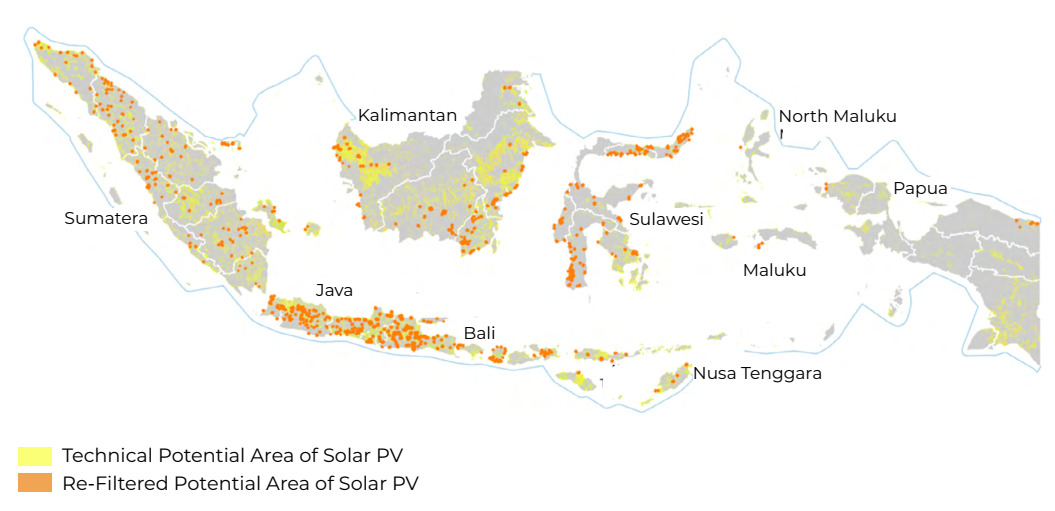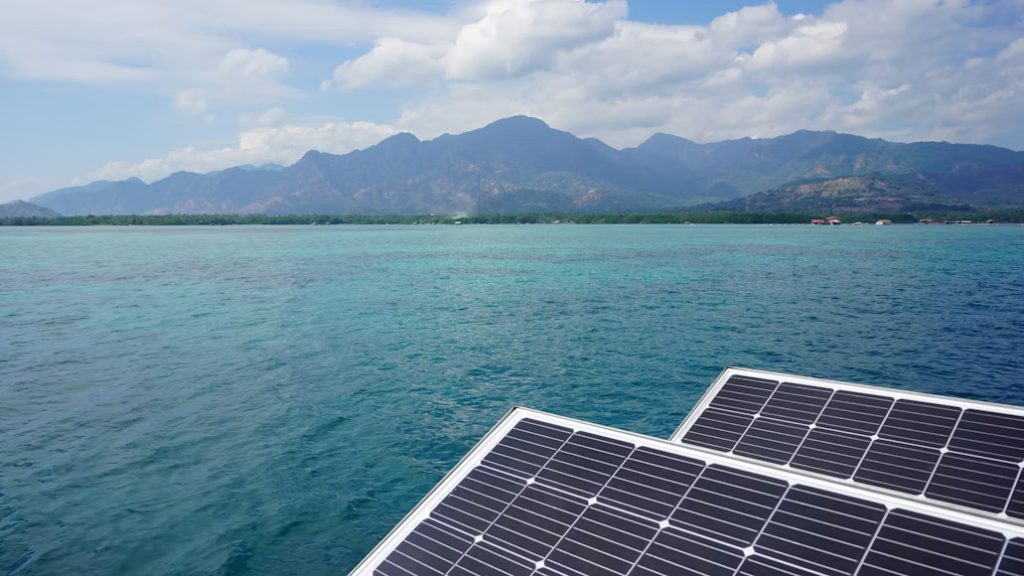The Future is Bright: Unlocking Indonesia’s Solar Potential
(AZ | 14/10/2025)
Unlocking Solar Energy Potential in Indonesia
Indonesia has pledged to achieve net zero emissions by 2060 or earlier, with ambitious interim goals for 2030. The government aims to cut emissions by up to 43.2% with global support, but the path forward requires a stronger shift to clean energy sources (IESR, 2024a; IESR, 2025). Renewable energy is central to this transition, offering opportunities not only to reduce emissions but also to improve energy security and stimulate economic growth. Among the available renewable options, solar photovoltaic (PV) stands out because of its abundance, falling costs, and suitability for both large-scale and distributed applications. With demand for electricity rising across the country, solar PV offers a practical and scalable way to power Indonesia’s transition toward a cleaner and more sustainable future.
Recent studies highlight the enormous renewable energy potential that Indonesia can harness. Geospatial analysis and financial modelling have identified over 1,500 potential sites for renewable projects, including 781 locations suitable for solar power. After refining the selection criteria, the total technical potential for ground-mounted solar installations across Indonesia is estimated at 336.5 GW (Figure 1). As shown in Figure 1, the re-filtered results indicate a more than 90% decrease in suitable land for solar PV compared to previous studies.
This reduction is primarily due to the implementation of stricter parameters during the filtering process. The two most significant constraints include maintaining the solar irradiance threshold at 4.5 kWh/m²/day and limiting site selection to areas within a 10 km radius of substations and high-voltage lines. Additional exclusions such as residential zones, water bodies, and hazard-prone areas also contributed to the decrease in total potential land area. This wide distribution shows that solar PV development is not limited to a few regions but can be deployed nationally to strengthen the grid and expand access. These findings confirm that Indonesia has both the natural resources and the economic conditions needed to scale up solar energy at an unprecedented pace.

Insights on Solar PV Performance from Local and Global Research
The performance of solar PV systems is highly dependent on the angle at which panels are installed. Tilt angle directly affects how much sunlight a panel receives, and optimizing this parameter can lead to significant gains in efficiency and energy production. In Indonesia, researchers have applied the Liu and Jordan Sky Isotropic Model to simulate optimal tilt angles for several cities, as shown in Table 1 (Kartikasari et al., 2023). The results demonstrate that different locations require different tilt settings to achieve maximum output, reflecting the country’s varied climate and atmospheric conditions. These insights show that adopting location-specific design strategies is critical to ensuring solar PV systems deliver their full potential.

Similar lessons can be drawn from research conducted outside Indonesia. Studies in Basra (Al-Sayyab et al., 2019), Pakistan (Ullah et al., 2019), China (Hua et al., 2020), and the United Arab Emirates (UAE) (Hachicha et al., 2019), confirm that optimal tilt angles vary depending on meteorological factors such as solar irradiance, temperature, and dust. For example, in Gansu, China, a tilt of 35° was found to balance energy generation and cost-effectiveness, while in Pakistan, soiling and dust accumulation presented unique performance challenges. More recent approaches use machine learning to combine multiple environmental variables, further improving predictive accuracy for tilt optimization. These global findings complement local research in Indonesia, highlighting the importance of tailoring solutions to specific regions and conditions. Together, they provide a strong foundation for advancing solar energy deployment.
Challenges Across Indonesia’s Diverse Landscapes
Despite its vast solar potential, Indonesia faces several obstacles in scaling up solar PV adoption. The country’s diverse geography and climate mean there is no one-size-fits-all tilt angle, as solar irradiance, cloud cover, and weather patterns differ significantly across provinces. This variation requires system designs that are carefully adapted to local environments rather than generalized solutions. In addition to natural factors, economic considerations such as land prices and grid connectivity play an equally important role in determining project feasibility. Without addressing these complexities, solar projects risk falling short of their expected performance and financial targets.
Another major challenge is maintaining long-term system efficiency in environments prone to dust, pollution, or heavy rainfall. Dust and soiling can cover panel surfaces, reducing the amount of sunlight captured and significantly decreasing output if left unaddressed. Studies in Pakistan (Ullah et al., 2019), and the UAE (Hachicha et al., 2019) show that soiling can reduce system efficiency by more than 20% without regular maintenance. This underlines the importance of both technical solutions, such as anti-soiling coatings, and operational practices, such as scheduled cleaning. By proactively addressing these risks, developers can safeguard the reliability and performance of solar PV systems, ensuring they continue to deliver sustainable energy over their lifetime.
Shaping the Future of Solar Energy with BWG
Recognizing both the opportunities and the challenges, PT Bhumi Warih Geohydromatics (BWG) has taken a stategic role in advancing solar PV optimization in Indonesia. Through its solar PV assessment, BWG provides data-driven, location-specific solutions designed to maximize renewable energy deployment across both offshore and onshore operations. By combining geospatial analysis, isotropic modelling, and references from global solar research, BWG develops system designs that reflect Indonesia’s diverse climatic and geographical realities.
By analysing key radiation parameters through detailed diurnal, seasonal, and annual assessments, BWG identifies a consistent 12-hour daily radiation window as the foundation for photovoltaic system performance. However, the substantial variability in radiation caused by cloud cover, monsoonal weather, and extreme climatic events emphasizes the importance of incorporating robust energy storage and backup systems to maintain supply reliability. The company’s modelling framework not only optimizes tilt angles for maximum energy yield but also integrates environmental risk assessments and operational recommendations to ensure system resilience in dynamic tropical environments.
This integrated approach ensures that every BWG project achieves both technical efficiency and long-term economic viability, aligning renewable energy systems with Indonesia’s sustainability goals. By translating advanced modelling techniques and global best practices into practical design strategies, BWG strengthens its position as a trusted partner in Indonesia’s energy transition. Our expertise bridges the gap between scientific insight and real-world implementation, helping to accelerate the adoption of solar PV as a dependable and sustainable component of Indonesia’s future energy mix.
Ready to power your project with optimized solar performance? Contact us at bw@bwgeohydromatics.com or connect with us on LinkedIn today.
References
Al-Sayyab, A. K. S., Al Tmari, Z. Y., & Taher, M. K. (2019). Theoretical and Experimental Investigation of Photovoltaic Cell Performance, With Optimum Tilted Angle: Basra City Case Study. Case Studies in Thermal Engineering, 14, 100421.
Hachicha, A. A., Al-Sawafta, I., & Said, Z. (2019). Impact of Dust on The Performance of Solar Photovoltaic (PV) Systems Under United Arab Emirates Weather Conditions. Renewable Energy, 141, 287-29.
Hua, Y., He, W., & Liu, P. (2020). Optimum Tilt Angles of Solar Panels: A Case Study for Gansu Province, Northwest China. Applied Solar Energy, 56, 388-396.
IESR (2024). Indonesia Energy Transition Outlook 2025: Navigating Indonesia’s Energy Transition at the Crossroads: A Pivotal Moment for Redefining the Future. Jakarta: Institute for Essential Services Reform (IESR).
IESR. (2024a). Navigating Indonesia’s Energy Transition at the Crossroads: A Pivotal Moment for Redefining the Future. IESR. p-ISSN 3032-0917
IESR. (2024b). Rekomendasi IESR Untuk Second NDC Indonesia. IESR. https://iesr.or.id/wp-content/uploads/2024/09/Rekomendasi-IESR-untuk-Second-NDC-Indonesia.pdf
IESR. (2025). Unlocking Indonesia’s Renewables Future: the Economic Case of 333 GW of Solar, Wind and Hydro Projects. Jakarta: Institute for Essential Services Reform (IESR).
Kartikasari, F. D., Tarigan, E., Irawati, F., Louk, M. H. L., Limanto, S., & Asmawati., E. (2023). Optimal Solar Panel Tilt Angle Calculation and Simulation in Indonesia: A Liu and Jordan Sky Isotropic Model-Based Approach. International Journal of Science and Research Archive, 09(02), 116-121.
Ullah, A., Imran, H., Maqsood, Z., & Butt, N. Z. (2019). Investigation of Optimal Tilt Angles and Effects of Soiling on PV Energy Production in Pakistan. Renewable energy, 139, 830-843.
Yunus Khan, T. M., Soudagar, M. E. M., Kanchan, M., Afzal, A., Banapurmath, N. R., Akram, N., & Shahapurkar, K. (2020). Optimum Location and Influence of Tilt Angle on Performance of Solar PV Panels. Journal of Thermal Analysis and Calorimetry, 141, 511-532.
